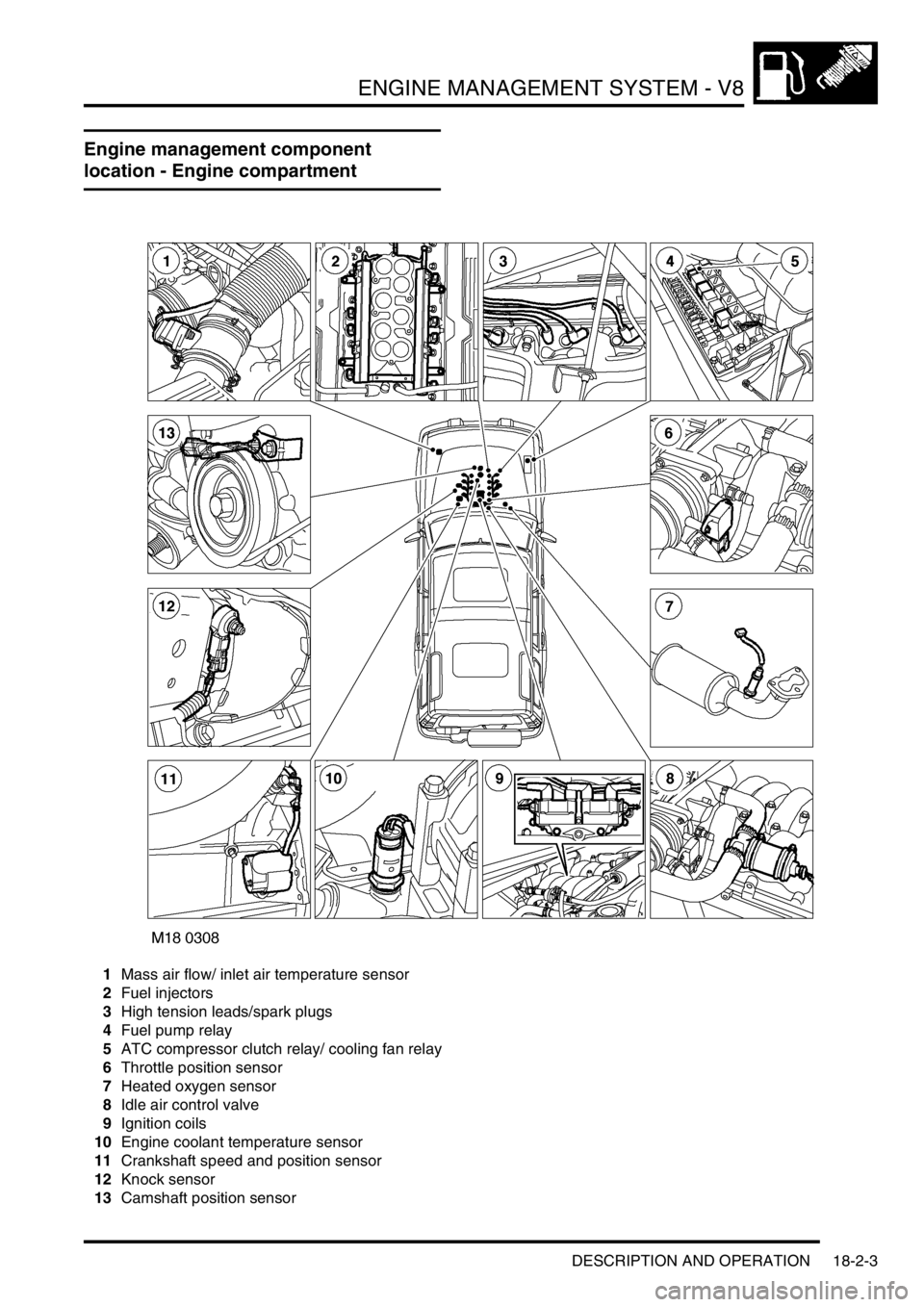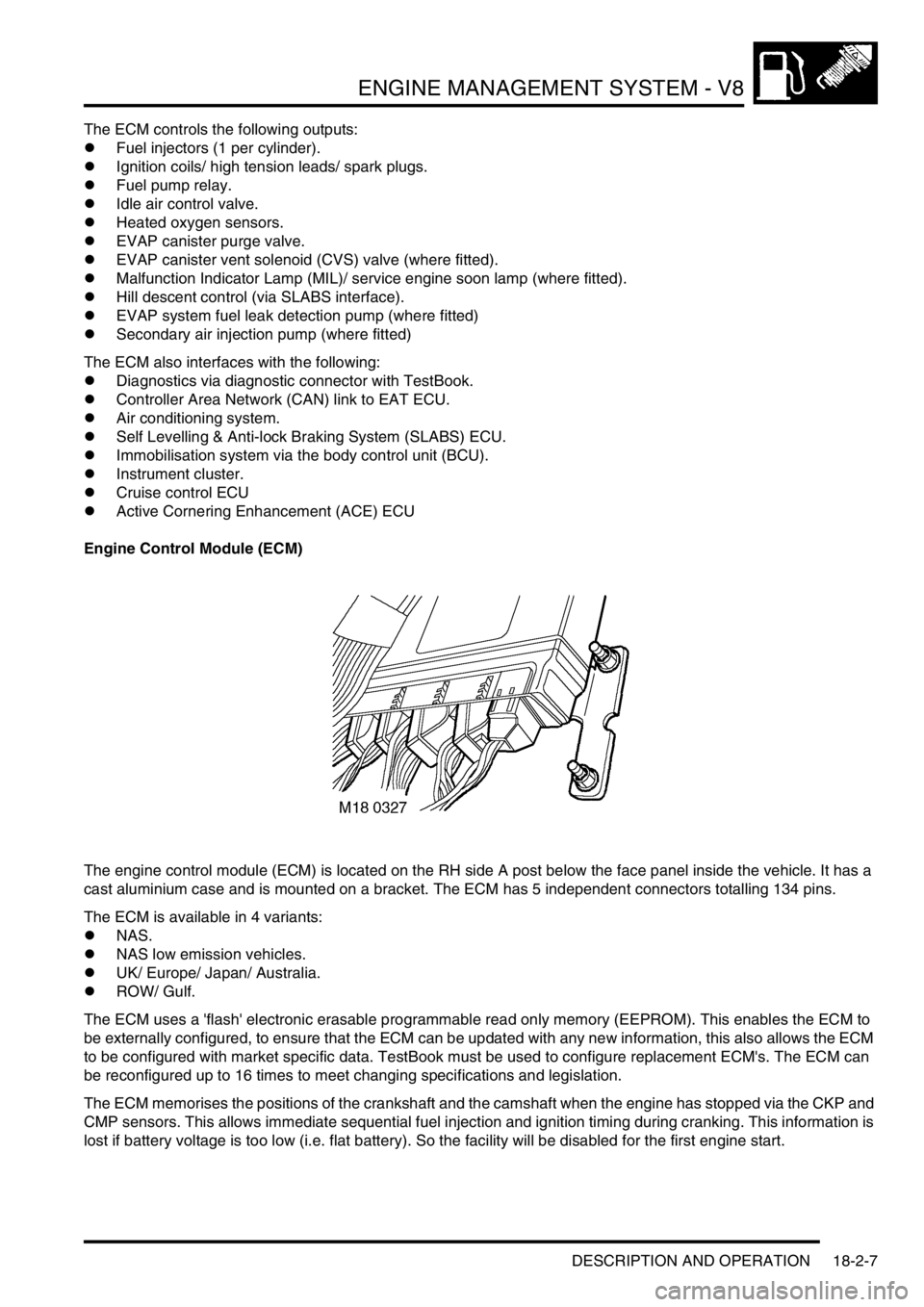sensor LAND ROVER DISCOVERY 2002 Workshop Manual
[x] Cancel search | Manufacturer: LAND ROVER, Model Year: 2002, Model line: DISCOVERY, Model: LAND ROVER DISCOVERY 2002Pages: 1672, PDF Size: 46.1 MB
Page 444 of 1672

ENGINE MANAGEMENT SYSTEM - TD5
REPAIRS 18-1-51
Sensor - mass air flow (MAF)
$% 19.22.25
Remove
1.Disconnect multiplug from MAF sensor.
2.Loosen clip and release air intake hose from
MAF sensor.
3.Release 2 clips and remove sensor from air
cleaner.
Refit
1.Position sensor to air cleaner and secure clips.
2.Position air intake hose and tighten clip.
3.Connect multiplug to MAF sensor.
Sensor - combined MAP and IAT
$% 19.22.26
Remove
1.Remove 3 bolts and remove engine acoustic
cover.
2.Disconnect multiplug from combined MAP and
IAT sensor,
3.Remove 2 bolts securing sensor to inlet
manifold.
4.Remove sensor and discard 'O' ring.
Refit
1.Clean sensor and inlet manifold mating face.
2.Fit new 'O' ring and position sensor to manifold.
3.Fit bolts securing MAP and IAT sensor and
tighten to 9 Nm (7 lbf.ft).
4.Fit engine acoustic cover and secure with
fixings.
Page 445 of 1672

ENGINE MANAGEMENT SYSTEM - TD5
18-1-52 REPAIRS
Sensor - ambient air pressure (AAP)
$% 19.22.27
Remove
1.Release 2 clips and disconnect MAF sensor
from air cleaner cover. 2.Release 2 clips and release cover from air
cleaner.
3.Disconnect multiplug from AAP sensor, remove
2 screws, remove sensor and discard 'O' ring.
Refit
1.Clean AAP sensor and air cleaner cover.
2.Fit new 'O' ring, fit sensor and tighten screws.
3.Position air cleaner cover and secure clips.
4.Connect multiplug to AAP sensor.
5.Position MAF sensor and secure clips.
Page 447 of 1672

ENGINE MANAGEMENT SYSTEM - TD5
18-1-54 REPAIRS
Sensor - Throttle position (TP)
$% 19.30.14
The TP sensor is integral with the throttle pedal
assembly and must be renewed as an assembly.
Three track TP sensors were introduced from VIN
297137.
Three track TP sensors cannot be fitted to vehicles
previously fitted with two track TP sensors.
Remove
1.Release diagnostic socket from driver's closing
panel.
2.Remove 3 trim retaining studs and remove
closing panel. 3.Disconnect multiplug from TP sensor, release
harness from throttle pedal bracket and
position harness aside..
4.Remove 2 nyloc nuts and remove throttle pedal
assembly. Discard nuts.
5.Remove spacer block from pedal bracket.
Refit
1.Position spacer block to pedal bracket.
2.Position throttle pedal assembly and tighten
new nyloc nuts to 13 Nm (10 lbf.ft).
3.Fit and secure harness to pedal bracket and
connect multiplug to TP sensor.
4.Position closing panel, connect diagnostic
socket and fit retaining studs.
Page 451 of 1672

ENGINE MANAGEMENT SYSTEM - TD5
18-1-58 REPAIRS
3.Fit brackets with rubber mountings to
intercooler and fit and tighten screws securing
brackets to condenser.
4.Fit radiator upper mounting brackets and
tighten bolts.
5.Fit LH horn and secure with nut.
6.Connect inlet and outlet hoses to intercooler
and tighten clips.
7.Fit lower half of fan cowl and secure with
screws.
8.Fit LH and RH air deflectors to front panel and
secure with scrivets.
9.Fit front grille.
10.Fit battery carrier and secure with bolts.
11.Fit ECM and secure with screw.
12.Fit jack to battery carrier.
13.Fit battery.
14.Fit cooling fan and coupling.
+ COOLING SYSTEM - Td5, REPAIRS,
Fan - viscous.
Valve - solenoid boost control
$% 19.42.30
Remove
1.Loosen clip and release air intake hose from
MAF sensor.
2.Release clips and disconnect vacuum hoses
from solenoid valve.
3.Disconnect multiplug from solenoid valve.
4.Remove 2 bolts and remove solenoid valve.
Refit
1.Position solenoid valve and tighten bolts.
2.Connect multiplug to solenoid valve.
3.Connect vacuum hoses and secure with clips.
4.Position air intake hose to MAF sensor and
secure clip.
Page 452 of 1672

ENGINE MANAGEMENT SYSTEM - TD5
REPAIRS 18-1-59
Regulator - fuel pressure
$% 19.45.06
Remove
1.Release turnbuckles and remove battery cover
2.Disconnect battery earth lead.
3.Remove 3 bolts and remove engine acoustic
cover.
4.Remove 2 bolts and remove engine lifting eye.
5.Position cloth to absorb fuel spillage.
6.Release and disconnect hose from fuel cooler. 7.Release and disconnect fuel hose from
pressure regulator.
Always fit plugs to open connections to
prevent contamination.
8.Disconnect multiplug from fuel temperature
sensor.
9.Remove 3 bolts, remove pressure regulator
from cylinder head and collect gasket.
10.Remove and discard 'O' ring and fuel filter.
Page 453 of 1672

ENGINE MANAGEMENT SYSTEM - TD5
18-1-60 REPAIRS
11.Remove fuel temperature sensor and discard
sealing washer.
12.Remove fuel hose and fuel pipe and discard 'O'
rings.
Refit
1.Clean fuel pressure regulator and mating face.
2.Clean fuel pipe unions.
3.Using new 'O' rings, fit fuel pipe and fuel hose
to pressure regulator and tighten unions to 25
Nm (18 lbf.ft).
4.Using new sealing washer, fit fuel temperature
sensor and tighten to 14 Nm (10 lbf.ft).
5.Fit new fuel filter and 'O' ring.
6.Using a new gasket, position pressure
regulator and tighten bolts to 25 Nm (18 lbf.ft).
7.Connect multiplug to fuel temperature sensor.
8.Connect fuel hoses to pressure regulator and
fuel cooler.
9.Fit engine lifting eye and tighten bolts to 25 Nm
(18 lbf.ft).
10.Fit engine acoustic cover and tighten bolts to 10
Nm (6 lbf.ft).
11.Connect battery earth lead.
12.Fit battery cover and secure fixings.
Glow plugs
$% 19.60.31
Remove
1.Remove 3 bolts and remove engine acoustic
cover.
2.Release turnbuckles and remove battery cover.
3.Disconnect battery earth lead.
4.Disconnect 4 glow plug leads.
5.Loosen and remove 4 glow plugs.
Refit
1.Thoroughly clean glow plugs and seating area
in cylinder head.
2.Apply a suitable anti-sieze compound to
threads of glow plugs.
3.Fit glow plugs and tighten to 16 Nm (12 lbf. ft).
4.Connect glow plug leads.
5.Fit engine acoustic cover and secure fixings.
6.Connect battery earth lead.
7.Fit battery cover and secure fixings.
Page 460 of 1672

ENGINE MANAGEMENT SYSTEM - V8
DESCRIPTION AND OPERATION 18-2-3
Engine management component
location - Engine compartment
1Mass air flow/ inlet air temperature sensor
2Fuel injectors
3High tension leads/spark plugs
4Fuel pump relay
5ATC compressor clutch relay/ cooling fan relay
6Throttle position sensor
7Heated oxygen sensor
8Idle air control valve
9Ignition coils
10Engine coolant temperature sensor
11Crankshaft speed and position sensor
12Knock sensor
13Camshaft position sensor
Page 462 of 1672

ENGINE MANAGEMENT SYSTEM - V8
DESCRIPTION AND OPERATION 18-2-5
1Engine control module
2Crankshaft speed and position sensor
3Camshaft position sensor
4Engine coolant temperature sensor
5Mass air flow/ inlet air temperature sensor
6Throttle position sensor
7Heated oxygen sensors
8Fuel injectors
9Idle air control valve
10Fuel pump relay
11EVAP canister
12EVAP canister vent valve
13EVAP canister purge valve
14Fuel tank pressure sensor
15Ignition coils
16Knock sensor
17Spark plugs
18High/ Low ratio switch
19Malfunction indication lamp
20Diagnostic connector
21Air temperature control clutch relay
22Air temperature control cooling fan relay
23ATC ECU
24CAN link to EAT
25SLABS ECU
26BCU
27Instrument cluster
28Thermostat monitoring sensor (where fitted)
Page 463 of 1672

ENGINE MANAGEMENT SYSTEM - V8
18-2-6 DESCRIPTION AND OPERATION
Description - engine management
General
The V8 engine is equipped with the Bosch Motronic M5.2.1 engine management system. This system is a sequential
multiport fuel injection system controlled by an Engine Control Module (ECM).
A single ECM is used for the control of the existing 4.0 litre engine and the new 4.6 litre engine introduced with 03
model year vehicles for the NAS market only. The ECM contains the tunes for both engines variants. When the ECM
is replaced, TestBook/T4 must be used to select the correct tune to match the engine fitment.
The ECM has On Board Diagnostic (OBD) strategies as required by various market legislative bodies. To meet these
requirements the system monitors and reports on any faults that cause excessive exhaust emissions.
In markets that mandate OBD, the ECM monitors performance of the engine for misfires, catalyst efficiency, exhaust
leaks and evaporative control loss. If a fault occurs, the ECM stores the relevant fault code and warns the driver of
component failure by illuminating the Malfunction Indicator Light in the instrument pack.
In markets where OBD is not mandatory, the ECM will still monitor performance of the engine and store the fault code,
but will not illuminate the Malfunction Indicator Light.
The ECM uses input and output information from its sensors and actuators to control the following engine conditions:
lFuel quantity.
lClosed loop fuelling.
lOpen loop fuelling.
lIgnition timing.
lKnock control.
lIdle speed control.
lEmission control.
lOn-Board Diagnostic (OBD) where applicable.
lVehicle immobilisation.
lMisfire detection (where applicable).
lVehicle speed signal.
lRough road signal (where applicable).
lLow fuel level signal (where applicable).
lCoolant temperature gauge signal.
The ECM processes sensor information from the following input sources:
lIgnition switch (position II).
lCrankshaft speed and position sensor.
lCamshaft position sensor.
lEngine coolant temperature sensor.
lMass air flow sensor.
lIntake air temperature sensor.
lKnock sensor.
lThrottle position sensor.
lHeated oxygen sensors.
lHigh/ Low ratio switch.
lFuel tank pressure sensor (where fitted)
lThermostat monitoring sensor (where fitted)
Page 464 of 1672

ENGINE MANAGEMENT SYSTEM - V8
DESCRIPTION AND OPERATION 18-2-7
The ECM controls the following outputs:
lFuel injectors (1 per cylinder).
lIgnition coils/ high tension leads/ spark plugs.
lFuel pump relay.
lIdle air control valve.
lHeated oxygen sensors.
lEVAP canister purge valve.
lEVAP canister vent solenoid (CVS) valve (where fitted).
lMalfunction Indicator Lamp (MIL)/ service engine soon lamp (where fitted).
lHill descent control (via SLABS interface).
lEVAP system fuel leak detection pump (where fitted)
lSecondary air injection pump (where fitted)
The ECM also interfaces with the following:
lDiagnostics via diagnostic connector with TestBook.
lController Area Network (CAN) link to EAT ECU.
lAir conditioning system.
lSelf Levelling & Anti-lock Braking System (SLABS) ECU.
lImmobilisation system via the body control unit (BCU).
lInstrument cluster.
lCruise control ECU
lActive Cornering Enhancement (ACE) ECU
Engine Control Module (ECM)
The engine control module (ECM) is located on the RH side A post below the face panel inside the vehicle. It has a
cast aluminium case and is mounted on a bracket. The ECM has 5 independent connectors totalling 134 pins.
The ECM is available in 4 variants:
lNAS.
lNAS low emission vehicles.
lUK/ Europe/ Japan/ Australia.
lROW/ Gulf.
The ECM uses a 'flash' electronic erasable programmable read only memory (EEPROM). This enables the ECM to
be externally configured, to ensure that the ECM can be updated with any new information, this also allows the ECM
to be configured with market specific data. TestBook must be used to configure replacement ECM's. The ECM can
be reconfigured up to 16 times to meet changing specifications and legislation.
The ECM memorises the positions of the crankshaft and the camshaft when the engine has stopped via the CKP and
CMP sensors. This allows immediate sequential fuel injection and ignition timing during cranking. This information is
lost if battery voltage is too low (i.e. flat battery). So the facility will be disabled for the first engine start.